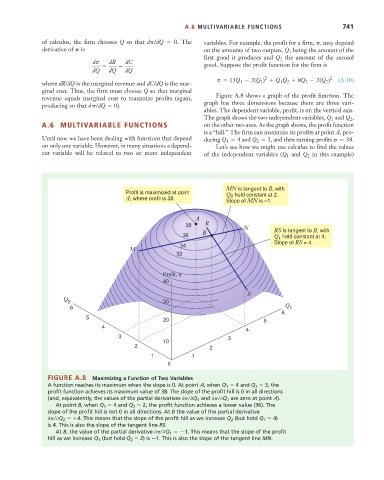Page 767 - Microeconomics, Fourth Edition
P. 767
BMappAMathematicalAppendix.qxd 8/17/10 1:10 AM Page 741
A.6 MULTIVARIABLE FUNCTIONS 741
of calculus, the firm chooses Q so that dp/dQ 0. The variables. For example, the profit for a firm, p, may depend
derivative of p is on the amounts of two outputs, Q 1 being the amount of the
first good it produces and Q 2 the amount of the second
dp dR dC
good. Suppose the profit function for the firm is
dQ dQ dQ
2
p 13Q 1 2(Q 1 ) Q 1 Q 2 8Q 2 2(Q 2 ) 2 (A.10)
where dR/dQ is the marginal revenue and dC/dQ is the mar-
ginal cost. Thus, the firm must choose Q so that marginal
revenue equals marginal cost to maximize profits (again, Figure A.8 shows a graph of the profit function. The
producing so that dp/dQ 0). graph has three dimensions because there are three vari-
ables. The dependent variable, profit, is on the vertical axis.
The graph shows the two independent variables, Q 1 and Q 2 ,
A.6 MULTIVARIABLE FUNCTIONS on the other two axes. As the graph shows, the profit function
is a “hill.” The firm can maximize its profits at point A, pro-
Until now we have been dealing with functions that depend ducing Q 1 4 and Q 2 3 , and then earning profits p 38 .
on only one variable. However, in many situations a depend- Let’s see how we might use calculus to find the values
ent variable will be related to two or more independent of the independent variables (Q 1 and Q 2 in this example)
MN is tangent to B, with
Profit is maximized at point Q held constant at 2.
2
A, where profit is 38. Slope of MN is –1.
A
38 R N
B RS is tangent to B, with
36 Q held constant at 4.
1
Slope of RS = 4.
M 34
32
Profit, π
40
S
Q
2 30
6 Q 1
6
5
20 5
4
4
3 3
10
2 2
1 1
0
FIGURE A.8 Maximizing a Function of Two Variables
A function reaches its maximum when the slope is 0. At point A, when Q 1 4 and Q 2 3, the
profit function achieves its maximum value of 38. The slope of the profit hill is 0 in all directions
(and, equivalently, the values of the partial derivatives 0p/0Q 1 and 0p/0Q 2 are zero at point A).
At point B, when Q 1 4 and Q 2 2, the profit function achieves a lower value (36). The
slope of the profit hill is not 0 in all directions. At B the value of the partial derivative
0p/0Q 2 4 . This means that the slope of the profit hill as we increase Q 2 (but hold Q 1 4)
is 4. This is also the slope of the tangent line RS.
At B, the value of the partial derivative 0p/0Q 1 1 . This means that the slope of the profit
hill as we increase Q 1 (but hold Q 2 2) is 1. This is also the slope of the tangent line MN.

